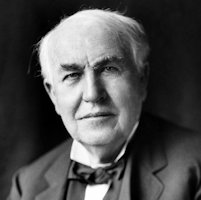
|
Some Common Myths Thought to be True - Myth 97
Myth 97: Thomas Edison Invented the Light Bulb
Edison did not invent the first electric light bulb, but instead invented the
first commercially practical incandescent light. Many earlier inventors had
previously devised incandescent lamps, including Alessandro Volta's
demonstration of a glowing wire in 1800 and inventions by Henry Woodward and
Mathew Evans. Others who developed early and commercially impractical
incandescent electric lamps included Humphry Davy, James Bowman Lindsay, Moses
G. Farmer, William E. Sawyer, Joseph Swan and Heinrich Göbel. Some of these
early bulbs had such flaws as an extremely short life, high expense to produce,
and high electric current drawn, making them difficult to apply on a large
scale commercially.
|
| Thomas Edison | |
|
Although the patent described several ways of creating the carbon filament
including "cotton and linen thread, wood splints, papers coiled in various
ways", it was not until several months after the patent was granted that Edison
and his team discovered a carbonized bamboo filament that could last over 1,200
hours. The idea of using this particular raw material originated from Edison's
recalling his examination of a few threads from a bamboo fishing pole while
relaxing on the shore of Battle Lake in the present-day state of Wyoming, where
he and other members of a scientific team had traveled so that they could
clearly observe a total eclipse of the sun on July 29, 1878, from the
Continental Divide.
|
|
| ⇦ Back to Myth 96 Return to Myth Choices Page 7 On to Myth 98 ⇨ | |